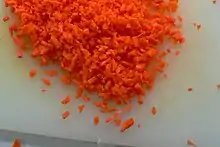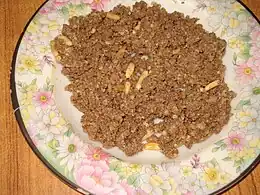

Mincing is a food preparation technique in which food ingredients are finely divided into uniform pieces.[1] Minced food is in smaller pieces than diced or chopped foods, and is often prepared with a chef's knife or food processor,[2][3] or in the case of meat by a specialised meat grinder.
For a true mince, the effect is to create a closely bonded mixture of ingredients and a soft or pasty texture.[3] However, in many recipes, the intention is for firmer foods such as onions and other root vegetables to remain in individual chunks when minced.[4]
Flavoring ingredients such as garlic, ginger, and fresh herbs may be minced in this way to distribute flavor more evenly in a mixture. Additionally, bruising of the tissue can release juices and oils to deliver flavors uniformly in a sauce. Mincemeat tarts/mince pies and pâtés employ mincing in the preparation of mouldable paste. Meat is also minced, and this cooking technique is used in Greek cuisine.
References
- ↑ "Mince - Definition and More from the Free Merriam-Webster Dictionary". Merriam-Webster Dictionary. Merriam-Webster, Incorporated. Retrieved 8 December 2011.
- ↑ Food Network (2003). Jennifer Darling (ed.). Food Network Kitchens Cookbook. Meredith Books. p. 268. ISBN 978-0-696-21854-5. Retrieved 8 December 2011.
- 1 2 Michael Ruhlman, Anthony Bourdain (2010). The Elements of Cooking: Translating the Chef's Craft for Every Kitchen (reprint ed.). Simon and Schuster. ISBN 978-1-4391-7252-0.
- ↑ Hertzmann, Peter (2007). Knife Skills Illustrated: A User's Manual. W. W. Norton & Company. ISBN 978-0-393-06178-9.
External links